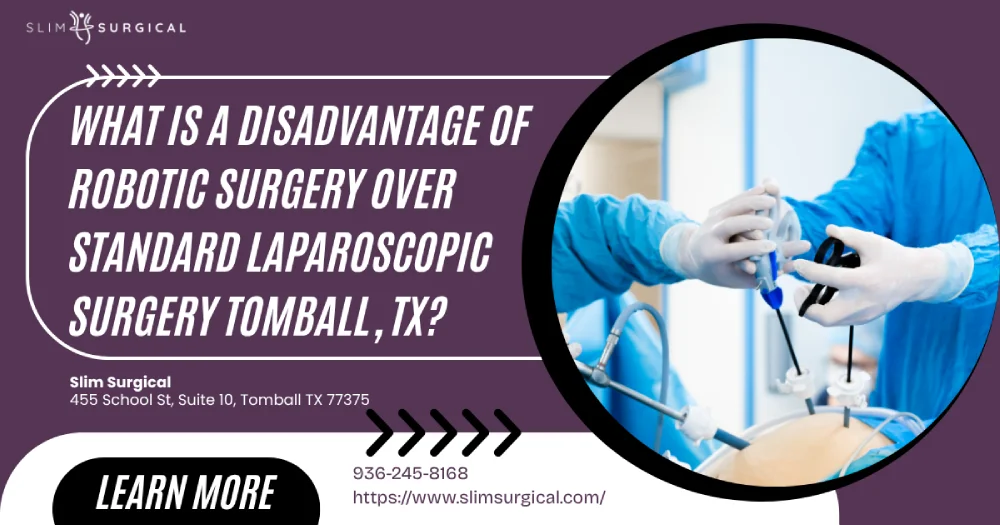
If you are exploring surgery options for minimally invasive hernia repair in Tomball, TX, it's important to weigh the differences between robotic surgery and standard laparoscopic surgery.
So, what is a disadvantage of robotic surgery over standard laparoscopic surgery in Tomball, TX?
The main disadvantage is cost. Robotic surgery involves expensive technology—such as the da Vinci surgical system—as well as extensive surgeon training and equipment maintenance. These factors increase costs for both hospitals and patients. In Tomball and Houston, this can mean higher out-of-pocket expenses, especially for those with limited insurance coverage.
Choosing between robotic surgery and standard laparoscopic surgery involves understanding subtle differences that go beyond cost. Both robotic and laparoscopic surgeries are hailed for minimizing incision size, reducing pain, and shortening the hospital stay, but the technology, surgical system, and skills required set them apart. Here is a side-by-side overview:
| Factor | Robotic Surgery | Standard Laparoscopic Surgery |
|---|---|---|
| Upfront Equipment Cost | Very High (da Vinci surgical system, robotic arms) | Moderate |
| Ongoing Maintenance | Expensive and frequent | Minimal |
| Surgeon Training | Advanced, prolonged learning curve in robotic | Widespread |
| Operating Room Setup | Longer (robotic system prep) | Shorter |
| Insurance Coverage | Sometimes limited | Widely accepted |
| Availability in Tomball, TX | Less common (robotic surgeons needed) | Widely available |
| Patient Out-of-Pocket | Potentially higher | Typically lower |
| Cosmetic Outcome | Similar | Similar |
| Recovery Time | Similar | Similar |
Clearly, the elevated costs linked to robotic vs laparoscopic approaches stem from technology, training, and potential insurance limitations. For hernia surgery in Tomball, TX, robotic hernia repair or robotic hernia surgery can be more expensive than laparoscopic.
The primary reasons robotic surgical techniques drive up costs are significant investments in the robotic surgical system itself—most notably the da Vinci robotic system, currently the industry leader in advanced robotic procedures. Hospitals must not only purchase these robotic arms and equipment but also pay for maintenance, disposable supplies, and intensive surgeon training.
All these expenses often translate to insurance reimbursement issues and higher patient bills in both Tomball, TX and Houston.
While price is a primary disadvantage of robotic surgery compared to standard laparoscopic surgery, other practical concerns apply to those seeking surgical options in the Tomball or Houston area.
Not all hospitals in Tomball, TX have invested in the latest advanced robotic systems. Availability may depend on hospital budgets, staff training, or the volume of candidates for robotic-assisted hernia repair and other procedures. Patients may be forced to travel, face delays, or select standard laparoscopic options instead.
For many considering robotic or laparoscopic care, insurance is a crucial factor. Some providers treat robotic vs laparoscopic as equivalent, but others may limit coverage for robotic procedures, especially for elective surgeries like certain hernia repairs. This sometimes results in elevated expenses for patients choosing robotic surgical methods in Houston or Tomball.
One less-discussed complication in robotic surgery is the risk of technical failure. If the robotic system malfunctions during a surgical procedure, the surgeon may have to switch to laparoscopic or open surgery manner. Address these potential issues with your Houston surgeon before undergoing robotic-assisted procedures.
Although advantages of robotic surgery include improved ergonomics and visualization for the surgeon, research shows that for most minimally invasive surgery cases—including ventral hernia repair—recovery time, incision size, and outcomes are similar whether you undergo laparoscopic or robotic techniques.
A major drawback of robotic surgery is the higher cost. Robotic procedures require expensive technology, more specialized surgeon training, and sometimes limited insurance coverage. These factors can make robotic hernia repair in Tomball or Houston more expensive than traditional laparoscopic hernia surgery.
Both robotic hernia repair and laparoscopic hernia repair usually use small incisions. The size is generally comparable, but robotic technology may offer improved maneuverability allowing for optimal incision placement, especially in complex cases or with obese patients.
For most patients, recovery time following robotic-assisted surgery and laparoscopic surgery is very similar. Both aim to minimize hospital stays, reduce pain, and promote faster returns to daily activities when compared to traditional open surgery.
No. Not every surgeon in Tomball, TX is trained in robotic surgical techniques. Additional certification is needed to use robotic systems, while laparoscopic skills are more commonly taught in general surgery training.
Insurance coverage for robotic surgery in Houston or Tomball can vary. Some plans consider robotic methods equivalent to other minimally invasive techniques, while others might view them as elective, affecting how much is covered.
While risks are generally low, unique complications to robotic-assisted surgery may include technical issues like robot malfunction, loss of tactile feedback, and the need to convert to open or laparoscopic surgery if problems arise during the procedure.
The da Vinci surgical system enhances a surgeon’s dexterity, visualization, and precision, especially in complex general surgery cases. These advantages of robotic systems may benefit select patients, but overall outcomes are similar to standard laparoscopic methods in many procedures.
Robotic colorectal surgery can provide improved instrument articulation for the surgeon, which may help with complex pelvic dissections. However, for many standard cases, both robotic and laparoscopic surgeries offer comparable benefits and recovery experiences.
Yes, one benefit of robotic-assisted techniques is improved access and control during surgery on obese patients. The technology may help the surgeon achieve better precision in challenging anatomical scenarios compared to standard laparoscopy.
The best choice depends on your individual case, hospital resources, and your surgeon's experience. Robotic hernia repair may offer benefits for complex or recurrent hernias, but laparoscopic surgery is effective, more available, and typically less expensive, especially in Tomball, TX.

Start your journey toward health and confidence with Slim Surgical. Our expert surgeon is here to guide you every step of the way with advanced care tailored to your goals.

2025 Slim Surgical. All right reserved. Website Design & SEO By: Authority Solutions®